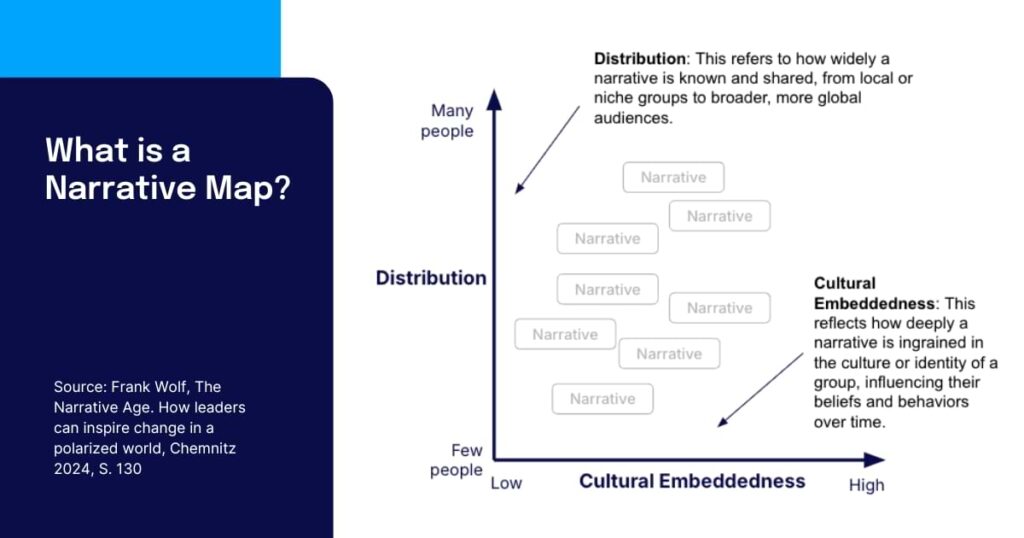When was the last time you truly changed your mind about something? It’s tough to change the narrative of something — most of us cling to familiar beliefs, especially when they feel personal. But what if there was a way to reshape perceptions and guide people toward new ideas naturally?
I remember seeing a powerful ad while walking through Chicago that used this exact approach. It took the common view of strength training and reframed it entirely, linking it not to personal health but to personal safety, a narrative that speaks to something far deeper and instinctive.
In this article, I’ll dive into how you can unlock this kind of transformation, learning how to change the narrative of how people view your organization by connecting with their core values and beliefs. I use insights from my book, The Narrative Age, to unlock the power of shifting a narrative and changing your company’s reputation.
Whether you’re dealing with bad press or aiming for reinvention, learning to reshape your company’s narrative is key to sustaining both inspiration and profitability. In this blog, I’ll cover:
- The kinds of narratives, including strategic narrative, that truly resonate with audiences
- Proven frameworks to strategically shift brand perception
- Inspiring examples of brands that used storytelling to win loyalty and reshape public opinion
Mapping the narrative landscape to see what narratives can change
To understand how to change the narrative of your company, you must first be familiar with the narrative landscape. One component of this is strategic narrative.
A company’s strategic narrative is more than a story — it’s a powerful, future-focused vision that combines mission and values to inspire people to take action together. Unlike typical messaging, a strategic narrative creates a shared picture of the future that rallies people toward common goals. However, this narrative doesn’t exist in isolation; it operates within a broader narrative landscape filled with cultural, historical, and societal influences.
To effectively shape, adapt, or even reinvent a strategic narrative, it’s essential to understand this landscape and recognize that brands enter a space filled with existing master narratives. For example, concepts like “Face Culture” in Asia, which emphasizes social harmony, or “Karma” in India, which centers on destiny and actions, are deeply ingrained and may impact how a narrative is received. These “sacred” narratives are deeply rooted, culturally embedded, and often resistant to change.
How do we understand which narratives are more resistant to change and which are too deeply ingrained in culture? A well-constructed narrative map helps brands find paths for evolution that respect deeply held beliefs, creating a more harmonious and effective narrative shift. This approach of narrative mapping allows for strategic adaptation, even when existing narratives challenge or constrain a brand’s message. Before you change the narrative of your company, you should first understand the narratives that surround it.
Creating a narrative map

A narrative map allows you to see how deeply embedded a narrative is in your culture, as well as how widely distributed it is.
- Identify Master Narratives: Determine the overarching beliefs and values in your audience’s worldview. This includes deep-seated cultural narratives that are unlikely to change and should be respected.
- Locate Flexible Narratives: Search for local or emerging narratives that may be more adaptable and align with your brand’s vision.
- Select Your Strategy: Use this map to decide if you should introduce an alternative narrative or confront existing beliefs head-on with a counternarrative.
A well-mapped narrative landscape allows brands to identify pathways for change without clashing with ingrained cultural beliefs, thus paving the way for smoother brand evolution.
Types of strategic narratives: Counternarratives vs. Alternative Narratives
Once you have a narrative map, choosing the right approach to shift your company’s narrative becomes clearer. Two powerful strategies can help you do this: counternarratives and alternative narratives. Let’s look at how each one works and how they can impact perception.
Option 1: Counternarratives
Counternarratives directly challenge an existing belief, often creating cognitive dissonance that prompts people to reconsider their views. This approach is best when an urgent change is needed or when the existing narrative harms the brand.
Take Beyond Meat, for example. Faced with the “ultra-processed” label, they countered it head-on by highlighting their product’s health and environmental benefits — reframing plant-based food as both nutritious and eco-friendly. The risk with counternarratives, however, is that they may reinforce resistance among audiences with deeply rooted beliefs.
Counternarrative Challenge: Counternarratives can be risky as they may reinforce existing beliefs among a resistant audience.
Option 2: Alternative Narratives
Alternative Narratives offer a different approach, introducing a new perspective that doesn’t directly oppose current beliefs but instead reinterprets them. For instance, remember the strength training ad mentioned earlier?
It cleverly shifted the conversation from “strength training is dangerous” to connecting strength training with personal safety, a deeply resonant value. Similarly, the city of Berlin’s rebranding from “poor and dysfunctional” to “poor but sexy” did not deny its imperfections but embraced them, appealing to a new audience drawn to authenticity.
Alternative Narrative Benefit: Alternative narratives offer a gentler approach, aligning with existing beliefs while still reframing perception.
By choosing the right type of narrative, brands can reposition themselves in a way that feels natural and appealing to their audience. But remember: you should not attempt to change the narrative of your company before you understand the narrative landscape.
Framing for impact: Leveraging cognitive dissonance and shared values
Changing a narrative isn’t just about introducing a new message; it’s about framing it in a way that resonates deeply. The key to impactful framing lies in managing cognitive dissonance carefully. When a new narrative challenges an existing belief, people may resist the change. However, by anchoring the narrative in shared values, brands can reduce this resistance and inspire openness. Here are some tips for effective narrative framing:
- Start with Shared Values: Focus on values that align with your audience’s beliefs. For example, when Lidl UK sought to change its image as a low-cost-only store, it acknowledged its past and humorously embraced it through the #LIDLsurprises campaign. By showcasing quality without denying affordability, Lidl reframed its narrative to naturally connect with customers’ expectations.
- Invite Curiosity and Pride: Position the narrative to evoke curiosity, empathy, or pride, making it feel like an extension of the audience’s worldview. This approach enables your audience to see the new message as a positive evolution rather than a disruptive change.
- Turn Cognitive Dissonance to Your Advantage: When managed well, cognitive dissonance can actually work in your favor. Align your message with values your audience already holds, inviting them to re-evaluate their beliefs in a way that feels affirming, not confrontational.
Beyond Meat and the discussion about ultra-processed food: Alternative and counternarratives in action
Changing a company’s narrative requires understanding both counter and alternative approaches — a strategy Beyond Meat demonstrates masterfully. In its early days, Beyond Meat positioned itself as a high-tech, eco-friendly solution to the environmental challenges associated with traditional meat.
However, traditional meat industry players soon countered this message, branding plant-based products as “ultra-processed” and unhealthy. To regain control, Beyond Meat launched a twofold narrative pivot that harnessed both counter and alternative narratives to redefine its reputation.
The Counter-Narrative
As the meat industry cast plant-based alternatives as overly processed, Beyond Meat responded by highlighting the health and environmental benefits of its products, directly challenging this “ultra-processed” label. The company’s “There is Goodness Here” campaign emphasized the simplicity and transparency of its ingredients, a counternarrative intended to dispel misinformation and address customer concerns head-on. This counter-narrative created cognitive dissonance, prompting consumers to question their assumptions and consider Beyond Meat’s message on health and sustainability.
The Alternative Narrative
Beyond Meat also introduced an alternative narrative that reframed plant-based meat as part of a wellness and sustainability lifestyle. Instead of merely countering the processed food narrative, this approach aligned plant-based meat with customers’ desire for cleaner, more environmentally conscious living. By embracing the purity of its ingredients and tapping into the wider master narrative of personal health and environmental stewardship, Beyond Meat attracted health-conscious and eco-minded customers without engaging in direct confrontation.
From this two-pronged strategy, Beyond Meat offers critical insights for successful narrative change:
- Align with Customer Values: By shifting to a narrative of natural ingredients and transparency, Beyond Meat resonated with evolving consumer priorities around wellness and sustainability.
- Stay Adaptive: A strategic narrative must remain flexible to adapt as market perceptions and consumer needs change, allowing Beyond Meat to reinforce its position despite industry resistance.
- Demonstrate Resilience: The success of Beyond Meat’s narrative shift highlights the power of guiding perception proactively, illustrating that a balanced mix of co
Final thoughts on how to change the narrative of a brand
A strategic narrative goes beyond shaping brand perception—it fosters a lasting emotional connection. By employing storytelling, narrative mapping, and skillful framing, brands can inspire action, loyalty, and a collective vision for the future.
As brands grow, they often need multiple narratives aligned around a central purpose or “North Star.” This constellation of narratives allows companies to speak meaningfully to employees, customers, and investors, each in a tailored yet unified voice. The more authentic and connected these narratives are to shared values, the stronger their impact.
Are you ready to craft your own strategic narrative? Let your brand’s future unfold through stories that captivate, inspire, and resonate with diverse beliefs and values.
For deeper insights, explore The Narrative Age and follow my updates on LinkedIn, where I discuss the transformative power of narrative in modern organizations. Also, check out Staffbase’s Mission Control for tools to amplify your brand’s communication impact.







